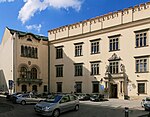Saints Peter and Paul Church, Kraków
1619 establishments in the Polish–Lithuanian Commonwealth16th-century Roman Catholic church buildings in Poland17th-century Roman Catholic church buildings in PolandChurch buildings with domesRoman Catholic churches completed in 1619 ... and 1 more
Roman Catholic churches in Kraków

The Church of Saints Peter and Paul (Polish: Kościół ŚŚ Piotra i Pawła) is a Roman Catholic Polish Baroque church located at 54 Grodzka Street in the Old Town district of Kraków, Poland. It was built between 1597–1619 by Giovanni Maria Bernardoni who perfected the original design of Józef Britius. It is the biggest of the historic Churches of Kraków in terms of seating capacity. Since 1842 it serves the Catholic All Saints parish.
Excerpt from the Wikipedia article Saints Peter and Paul Church, Kraków (License: CC BY-SA 3.0, Authors, Images).Saints Peter and Paul Church, Kraków
Józefa Dietla, Krakow Stare Miasto (Old Town)
Geographical coordinates (GPS) Address Nearby Places Show on map
Geographical coordinates (GPS)
| Latitude | Longitude |
|---|---|
| N 50.056611111111 ° | E 19.938277777778 ° |
Address
Historyczne centrum Krakowa
Józefa Dietla
31-073 Krakow, Stare Miasto (Old Town)
Lesser Poland Voivodeship, Poland
Open on Google Maps











